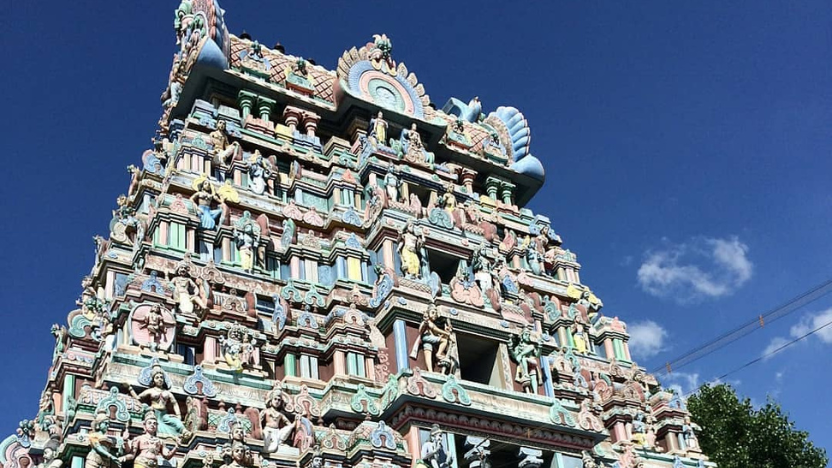A beautiful story of this temple. Nestled in the outskirts of Kumbakonam in Tamil Nadu, the Kalyanasundaresar Temple in Nallur also known as Thirunallur is one of the most remarkable shrines dedicated to Lord Shiva. Revered for its deep-rooted spiritual significance and architectural legacy, the temple stands as a testament to Tamil Saiva tradition and centuries-old devotion.
Lord Shiva is worshipped here as Kalyanasundaresar, represented by a self-manifested lingam (Swayambhu), while Goddess Parvati appears in the sanctum as Girisundari. This sacred temple finds mention in the 7th-century Tamil Saiva canonical literature, Tevaram, sung by the saint poets known as the Nayanmars, including Appar, Sundarar, and Thirugnana Sambandar.
The temple is intrinsically linked to the tales of Sage Agastya and Amaraneethi Nayanar, one of the 63 Saiva saints. It is said that Amaraneethi attained salvation here through his unwavering devotion. What sets this temple apart, however, is a divine phenomenon that continues to draw devotees and scholars alike ; the presiding lingam changes colour five times a day, reflecting different divine aspects of Lord Shiva during the various phases of worship.
Heard about a Unique #Shiva Lingam that
changes colour 5 times a day for every 2 hours and 20 mins.
This Shiva Lingam is Swamyabhu
(Naturally formed)located -
Kalyanasundaresar Temple, Nallur/ Thirunallur near Kumbakonam,TN
And the deity is also called
Pancha varneswarar.
1/n pic.twitter.com/jJk8yKHHpj— SK (@sk_diary1) July 20, 2020
Five Avatars, Five Phases of Worship
The sacred lingam undergoes a visible transformation throughout the day, a phenomenon regarded as divine and unique:
Morning (6 AM – 8.24 AM): The lingam turns copper colour, representing Shiva as Vaidyanatha, the divine healer. He is adorned with a golden crown, carries an axe and an arrow, and is accompanied by Nandi, who stands on hind legs facing east or north. Devotees offer worship to the Chakra during this period.
Morning (8.25 AM – 10.48 AM): The lingam turns light red, signifying the Lord as Neelakanta Purusha, Kshirasagara Sambhu, and other auspicious forms. Devotees offer flowers and sandalwood paste according to specific wishes.
Noon ( 10.49 AM – 1.12 PM): The lingam turns molten gold colour, symbolizing passion and divine energy.
Noon (1.13 PM – 3.36 PM): The lingam adopts a emerald green, representing tranquillity and wisdom.
Noon (3.37 PM – 6 PM): A colour the Devotee has in mind and wants to see.
This rare phenomenon emphasizes Shiva’s ever-changing yet eternal nature, making the temple a site of both spiritual and metaphysical curiosity.

Let’s talk about the history of the temple…
The origins of the Kalyanasundaresar Temple trace back over a thousand years. It is believed that Pandya king Rajaraja Chola I (985–1013 CE) was instrumental in its early construction, with subsequent renovations across centuries preserving its grandeur. There are also mentions of a king named Mallikarjuna Maharaja contributing to its development in 1117 AD.
Architecturally, the temple stands as a classic example of South Indian Dravidian style. The sanctum is surrounded by intricately carved halls and prakaras, built primarily from sandstone and marble. Some sections are said to be adorned with gold foil, enhancing the temple’s aesthetic and spiritual aura.
A unique Vilvam tree, believed to be the first of its kind on Earth, grows within the temple premises, earning it the title Aadhi Vilvam. Another rare feature is the presence of Gananatha. A form of Shiva enshrined in the balipeeta (sacrificial altar). Outside of Varanasi, this is the only other known temple where Gananatha appears in this form.
Adding to its mystique, the temple houses two black stone lingams. One rests in the sanctum and is clad in gold, while the second, near the entrance, is covered daily with sandalwood paste at dawn by 9 AM, it gleams like a golden idol.
Indeed, the Kalyanasundaresar Temple is not just a shrine, it is a living chronicle of Tamil Nadu’s rich Saiva heritage.
Source / Image Credit : @sk_diary1, TeluguOne.com, Secret Temples







